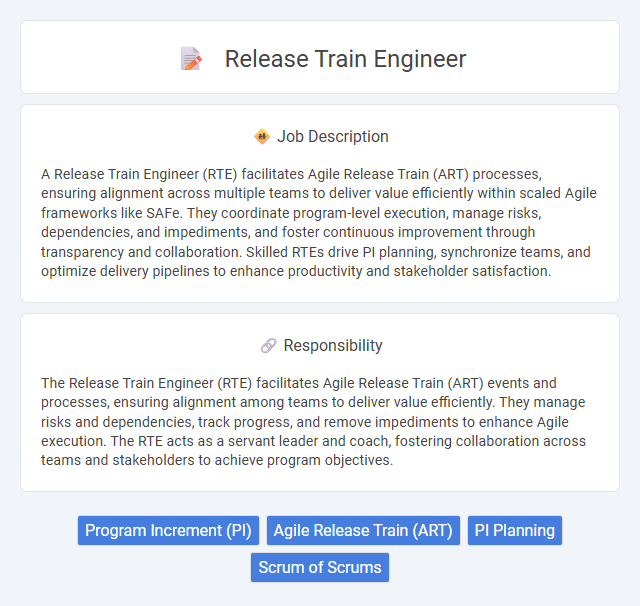
A Release Train Engineer (RTE) facilitates Agile Release Train (ART) processes, ensuring alignment across multiple teams to deliver value efficiently within scaled Agile frameworks like SAFe. They coordinate program-level execution, manage risks, dependencies, and impediments, and foster continuous improvement through transparency and collaboration. Skilled RTEs drive PI planning, synchronize teams, and optimize delivery pipelines to enhance productivity and stakeholder satisfaction.
Individuals with strong leadership skills, excellent communication, and a knack for facilitating collaboration are likely to thrive as a Release Train Engineer. Those who excel in managing complex projects, coordinating cross-functional teams, and maintaining a focus on Agile principles may find this role particularly suitable. Candidates who prefer structured environments and enjoy driving continuous improvement in software release processes probably fit well in this position.
Qualification
A Release Train Engineer (RTE) requires strong expertise in Agile frameworks, particularly SAFe (Scaled Agile Framework), with certifications such as SAFe Program Consultant (SPC) or Certified ScrumMaster (CSM) enhancing their qualifications. Proven experience in facilitating cross-team collaboration, managing program-level risks, and driving continuous improvement across multiple Agile teams is essential. Exceptional communication, leadership skills, and the ability to coordinate complex delivery schedules ensure successful large-scale product releases.
Responsibility
The Release Train Engineer (RTE) facilitates Agile Release Train (ART) events and processes, ensuring alignment among teams to deliver value efficiently. They manage risks and dependencies, track progress, and remove impediments to enhance Agile execution. The RTE acts as a servant leader and coach, fostering collaboration across teams and stakeholders to achieve program objectives.
Benefit
The role of a Release Train Engineer likely enhances team collaboration and streamlines project delivery by coordinating Agile Release Trains effectively. Companies probably benefit from increased productivity and reduced time-to-market due to the facilitation of continuous improvement and risk management. This position may also improve communication across cross-functional teams, fostering alignment and transparency throughout the development process.
Challenge
The Release Train Engineer role likely involves significant challenges in coordinating multiple Agile teams to ensure smooth and timely delivery of complex projects. Managing dependencies and resolving conflicts between teams may require strong communication and problem-solving skills under pressure. It is probable that balancing evolving priorities and maintaining alignment with strategic goals contributes to a demanding work environment.
Career Advancement
Release Train Engineers (RTEs) play a pivotal role in Agile Release Train (ART) facilitation, coordinating teams to deliver large-scale software solutions efficiently. Career advancement for RTEs often leads to senior agile roles such as Agile Program Manager or Portfolio Manager, leveraging expertise in cross-team collaboration and Lean-Agile methodologies. Mastery of SAFe frameworks and strong leadership skills significantly enhance opportunities for promotion and higher responsibility in enterprise agile transformations.
Key Terms
Program Increment (PI)
A Release Train Engineer (RTE) plays a critical role in orchestrating Program Increment (PI) planning, ensuring alignment across Agile teams within the Agile Release Train (ART). The RTE facilitates PI events, manages risks, dependencies, and impediments, and drives continuous delivery of value throughout the PI cycle. Effective PI execution by the RTE leads to improved predictability, quality, and collaboration across the program.
Agile Release Train (ART)
A Release Train Engineer (RTE) is the servant leader and chief Scrum Master for an Agile Release Train (ART), facilitating program-level Agile processes and execution. The RTE coordinates cross-team dependencies, manages risks, and ensures continuous delivery of value by aligning agile teams with organizational objectives. Key responsibilities include facilitating PI planning, tracking ART progress, and driving relentless improvement to optimize Agile Release Train performance.
PI Planning
A Release Train Engineer (RTE) facilitates PI Planning by coordinating cross-functional teams to align on objectives and deliverables within a Program Increment. They ensure effective communication, manage dependencies, and resolve bottlenecks to optimize workflow and meet deadlines. Expertise in Agile frameworks and tools like SAFe is crucial for driving continuous improvement during PI Planning sessions.
Scrum of Scrums
Release Train Engineers (RTEs) coordinate multiple Agile teams by facilitating Scrum of Scrums meetings to ensure alignment and synchronization across the Agile Release Train (ART). These meetings address cross-team dependencies, risks, and impediments, optimizing value delivery and maintaining continuous flow. RTEs serve as servant leaders, driving collaboration and transparency among teams within scaled Agile frameworks such as SAFe.
 kuljobs.com
kuljobs.com